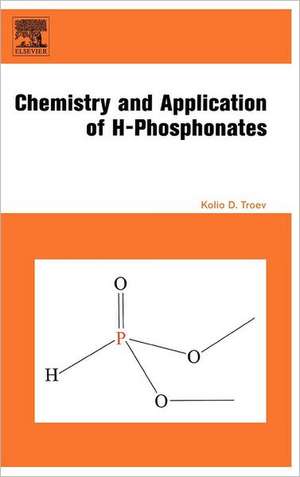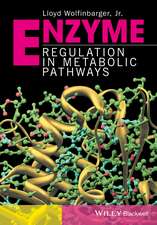Chemistry and Application of H-Phosphonates
Autor Kolio D. Troeven Limba Engleză Hardback – 18 iul 2006
Alpha-Aminophosphonic acids are an important class of biologically active compounds, which have received an increasing amount of attention because they are considered to be structural analogues of the corresponding Alpha-amino acids. The utilities of alpha-aminophosphonates as peptide mimics, haptens of catalytic antibodies, enzyme inhibitors, inhibitors of cancers, tumours, viruses, antibiotics and pharmacologic agents are well documented. Alpha-Hydroxyalkanephosphonates are compounds of significant biological and medicinal applications. Dialkyl epoxyalkylphosphonates are of interest because of their use as intermediates in the synthesis of bioactive substances, and as modifiers of natural and synthetic polymers. Bisphosphonates are drugs that have been widely used in different bone diseases, and have recently been used successfully against many parasites. Poly(alkylene H-phosphonate)s and poly(alkylene phosphate)s are promising, biodegradable, water soluble, new polymer-carriers of drugs. Nucleoside H-phosphonates seem to be the most attractive candidates as starting materials in the chemical synthesis of DNA and RNA fragments. The 5’-hydrogen phosphonate-3’-azido-2’,3’-dideoxythimidine is one of the most significant anti-HIV prodrug, which is currently in clinical trials.
Chapters review the synthesis; physical and spectral properties (1H, 13C, 31P and 17O NMR data); characteristic reactions; important classes of compounds based on these esters of H-phosphonic acid; their application as physiologically active substances, flame retardants, catalysts, heat and light stabilizers, lubricants, scale inhibitors, polymer-carriers of drugs; preparation of H-phosphonate diesters and general procedures for conducting the most important reactions.
* provides ideas for the synthesis of phosphonates, phosphoramides and diesters of phosphonic acid (new phosphorus-containing compounds)* reviews structure, spectra and biological activity of H-phosphonates and their derivatives* examines new areas of application of phosphorus-containing compounds
Preț: 1987.91 lei
Preț vechi: 2723.16 lei
-27% Nou
Puncte Express: 2982
Preț estimativ în valută:
380.38€ • 397.15$ • 314.82£
380.38€ • 397.15$ • 314.82£
Carte tipărită la comandă
Livrare economică 04-18 aprilie
Preluare comenzi: 021 569.72.76
Specificații
ISBN-13: 9780444527370
ISBN-10: 0444527370
Pagini: 336
Ilustrații: 1
Dimensiuni: 165 x 240 x 19 mm
Greutate: 0.58 kg
Ediția:New.
Editura: ELSEVIER SCIENCE
ISBN-10: 0444527370
Pagini: 336
Ilustrații: 1
Dimensiuni: 165 x 240 x 19 mm
Greutate: 0.58 kg
Ediția:New.
Editura: ELSEVIER SCIENCE
Public țintă
For Professors, researchers, students and practitioners working in the fields of organophosphorus Chemistry, Organic Chemistry, Polymer Chemistry, Pharmacy, Production of polymers with reduced flammability, Production of agrochemicals, Medicinal ChemistryCuprins
Chapter 1. Methods for preparation and physical properties of H-phosphonates 1.1. From phosphorus trichloride and alcohols 1.2. From H-phosphonic acid 1.3. From white phosphorus and alcohols 1.4. Others 1.5. Physical properties 1.6. Thermal stabilityChapter 2. Structure and spectral characteristics of H-phosphonates 2.1. Electronic structure of phosphorus atom2.2. Nature of the chemical bonds in phosphoryl group2.3. Molecular structure of dimethyl H-phosphonate 2.4. Tautomerization of dialkyl H-phosphonates 2.5. Spectral characteristics
Chapter 3. Reactivity of H-phosphonates3.1. Acidity of H-phosphonate diesters 3.2. Disproportionation 3.3. Reduction3.4. Hydrolysis 3.5. Acidolysis 3.6. Substitution reactions at the phosphorus atom
Chapter 4. Important classes of compounds 4.1. Aminophosphonic acids 4.2. Bisphosphonates 4.3. Nucleoside H-phosphonates4.4. Epoxyalkylphosphonates 4.5. Poly(alkylene H-phosphonate)s 4.6. Metal salts of dialkyl H-phosphonates 4.7. Complexes of dialkyl H-phosphonates
Chapter 5. Application of H–phosphonates and their derivatives5.1. Physiologically-active substances5.2. Polymer additives5.3. Degrading and alkylating agents of polymers 5.4. Heat, light and UV stabilizers 5.5. Catalysts 5.6. Corrosion inhibitors 5.7. Scale inhibitors 5.8. Lubricants
Chapter 3. Reactivity of H-phosphonates3.1. Acidity of H-phosphonate diesters 3.2. Disproportionation 3.3. Reduction3.4. Hydrolysis 3.5. Acidolysis 3.6. Substitution reactions at the phosphorus atom
Chapter 4. Important classes of compounds 4.1. Aminophosphonic acids 4.2. Bisphosphonates 4.3. Nucleoside H-phosphonates4.4. Epoxyalkylphosphonates 4.5. Poly(alkylene H-phosphonate)s 4.6. Metal salts of dialkyl H-phosphonates 4.7. Complexes of dialkyl H-phosphonates
Chapter 5. Application of H–phosphonates and their derivatives5.1. Physiologically-active substances5.2. Polymer additives5.3. Degrading and alkylating agents of polymers 5.4. Heat, light and UV stabilizers 5.5. Catalysts 5.6. Corrosion inhibitors 5.7. Scale inhibitors 5.8. Lubricants






